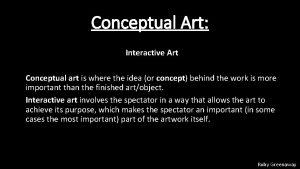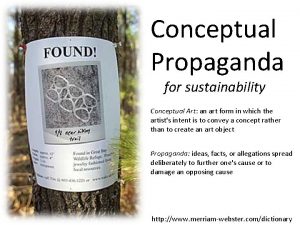Conceptual Art In conceptual art the idea or











- Slides: 11

Conceptual Art In conceptual art the idea or concept is the most important aspect of the work. When an artist uses a conceptual form of art, it means that all of the planning and decisions are made beforehand the execution is a perfunctory affair. The idea becomes a machine that makes the art.

Conceptual art, sometimes simply called Conceptualism, is art in which the concept(s) or idea(s) involved in the work take precedence over traditional aesthetic and material concerns. Many works of conceptual art, sometimes called installations, may be constructed by anyone simply by following a set of written instructions.

Marcel Duchamp In conceptual art the idea or concept is the most important aspect of the work. When an artist uses a conceptual form of art: The idea becomes a machine that makes the art. The Fountain 1917

Joseph Kosuth One and three Chairs, 1965 Conceptual Art A term used from about 1967 onwards to describe art in which the idea, and the process of making, takes precedence over the finished product. In extreme cases the work consists simply of a set of instructions, or an action by the artist.

Joseph Beuys Chair with fat, 1964 These works of art are part of Beuys’ broader artistic strategy, which can be called “shamanism. ” Beuys often used natural materials and cult-like ceremonies through which he tried to underline the importance of the irrational and mystical in human beings. With this practice, Beuys tried to oppose the “rational” in contemporary society. He perceived his art as a social mission, needed to heal post-war German society.

MY BAG!

The Havana-based artist, who has held one-person exhibitions in Canada, Ecuador, the Republic of Cameroon, Switzerland, and leading galleries in Cuba, along with participating in five dozen group shows in leading galleries in North and South America and Europe, will exhibit more than 150 new paintings and wall-mounted installations of canvas and paper “shopping bags” shaped into letters from his two new series, Dissident and Exile. Fourteen of the four-foot Dissident paintings, each in a different language, will be in “Vincench vs Vincench: A Dissident Dialogue from Cuba. ” Vincench superimposes a stencil of the definition of dissent in each language over an abstract painting, obscuring parts of the words with a white overlay that allows a faint suggestion of the original painting to be seen.

In her El Nuevo Herald review on Sept. 4 th curator and art critic Janet Batet noted that “With a highly rigorous conceptual proposal, Vincench bases his work in art historyspecifically the Cuban tradition of abstract art-deconstructing the Cuban reality and encouraging a critical reading. Relying, as central subject, in the social and religious entity that embodies the Cuban, the artist undertakes research areas, typical of sociology, integrating popular beliefs, personal life experiences and current sociopolitical events of recent history of the island. ” In this instance, the artist is targeting the sociopolitical phenomena of dissent. “In Cuba, a dissident is the very worst thing you can be, ” Vincench explains. “No one wants to be associated with a dissident. Because I am an artist, an intellectual, I see things differently. I want to show people that dissidence is just another way of looking at something. ”

D. E. S. T. I. E. R. R. O. , 19 1/2 x 100 x 5 1/2 inches, Ed. 5, and a painting of the installation, 2011

The Oklahoma City National Memorial is a memorial in the United States that honors the victims, survivors, rescuers, and all who were affected by the Oklahoma City bombing on April 19, 1995. The memorial is located in downtown Oklahoma City on the former site of the Alfred P. Murrah Federal Building, which was destroyed in the 1995 bombing. This building was located on NW 5 th Street between N. Robinson Avenue and N. Harvey Avenue.




















